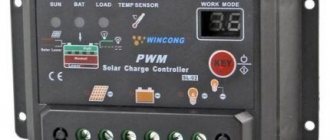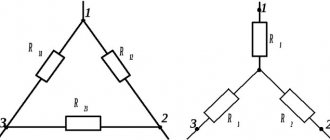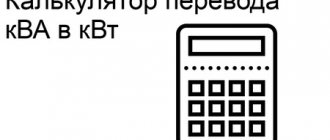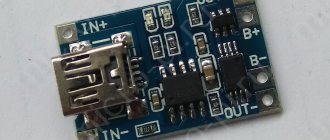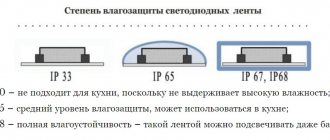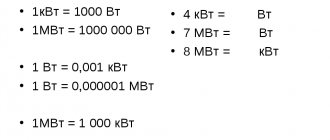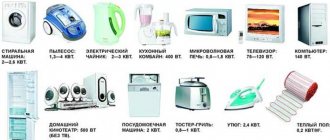');> //–> Ampere is a unit of measurement of electric current in the International System of Units (SI).
1 amp = 1000 milliamps
You can quickly perform this simple mathematical operation using our online program. To do this, enter the initial value in the appropriate field and click the button.
For complex calculations to convert several units of measurement into the required one (for example, for mathematical, physical or budget analysis of a group of positions), you can use universal unit converters.
This page provides the simplest online converter of units of measurement from milliamps to amperes. With this calculator you can convert mA to A and vice versa in one click.
');> //–> Ampere is a unit of measurement of electric current in the International System of Units (SI).
1 amp = 1000 milliamps
You can quickly perform this simple mathematical operation using our online program. To do this, enter the initial value in the appropriate field and click the button.
For complex calculations to convert several units of measurement into the required one (for example, for mathematical, physical or budget analysis of a group of positions), you can use universal unit converters.
This page provides the simplest online converter of units of measurement from milliamps to amperes. With this calculator you can convert mA to A and vice versa in one click.
Ampere
(Russian designation:
A
; international:
A
) is a unit of measurement of electric current in the International System of Units (SI), one of the seven basic SI units.
Magnetomotive force and magnetic potential difference are also measured in amperes (outdated name - ampere-turn
) [1]. In addition, the ampere is a unit of current and is one of the basic units in the ICSA system of units.
Definition [edit | edit code]
On November 16, 2022, at the XXVI General Conference of Weights and Measures, a new definition of ampere was adopted, based on the use of the numerical value of the elementary electric charge. The wording, effective May 20, 2022, reads [2]:
The ampere, symbol A, is the SI unit of electric current. It is determined by fixing the numerical value of the elementary charge equal to 1.602 176 634⋅10 −19, when it is expressed in unit C, which is equal to A s, where the second is defined through Δ ν C su _>> [3].
Methods for converting current value
For modern energy-intensive household appliances, currents of several amperes or more work quite well, and it is not difficult to use this unit of measurement. The cheapest devices include:
- Computer;
- Laptop;
- Regular smartphones and cell phones;
- MP3 players, set-top boxes;
- LCD – lighting equipment;
- LCD – video devices (monitors, televisions);
- Pills;
- E-books;
- Navigators;
- VCRs.
Typical current consumption of these devices ranges from tens to hundreds of milliamps. To correctly convert amps to milliamps, remember that the prefix "milli" means one thousandth of the base unit. You can use 10 -3 or 0.001 as the numerical factor. The use of such a multiple or fractional unit is quite acceptable and legalized by national legislation in the form of GOST 8.417-2002 “Interstate standard. Unit of quantity."
The abbreviated designation of the prefix “milli” in the Russian version is “m”, in the international version it is “m”. Therefore, it is quite clear that 1000 milliamps is equal to 1 ampere.
Multiples and submultiples [edit | edit code ]
In accordance with the full official description of the SI contained in the current edition of the SI Brochure (French Brochure SI, English The SI Brochure), published by the International Bureau of Weights and Measures (BIPM), decimal multiples and submultiples of the ampere are formed using standard SI prefixes [ 5] . “Regulations on units of quantities allowed for use in the Russian Federation”, adopted by the Government of the Russian Federation, provides for the use of the same prefixes in Russia [7].
| Multiples | Dolnye | ||||||
| magnitude | Name | designation | magnitude | Name | designation | ||
| 10 1 A | dekaampere | yesA | daA | 10 −1 A | deciampere | Yes | dA |
| 10 2 A | hectoampere | gA | hA | 10 −2 A | centiampere | sA | cA |
| 10 3 A | kiloampere | kA | kA | 10 −3 A | milliampere | mA | mA |
| 10 6 A | megaampere | MA | M.A. | 10 −6 A | microampere | µA | µA |
| 10 9 A | gigaampere | GA | GA | 10 −9 A | nanoampere | on | nA |
| 10 12 A | teraampere | TA | T.A. | 10 −12 A | picoampere | pA | pA |
| 10 15 A | petaampere | PA | PA | 10−15 A | femtoamp | F | fA |
| 10 18 A | exaampere | EA | E.A. | 10 −18 A | attoampere | aA | aA |
| 10 21 A | zettaampere | BEHIND | ZA | 10−21 A | zeptoamp | behind | zA |
| 10 24 A | Iottaampere | IA | YA | 10−24 A | ioctoampere | iA | yA |
| not recommended for use | |||||||
How to measure
In order to determine the current strength in a specific section of the circuit, the measuring instruments listed above are used. Among them, the most accurate is the ammeter, which measures only one value using one scale. However, testers and multimeters are considered more convenient, with the help of which they measure not only current strength, but also other electrical quantities in various ranges. These devices have the ability to switch from one unit of measurement to another and accurately determine how many milliamps are in an ampere.
Summary
There are two ways to convert milliamps to amperes. The first of them is to carry out arithmetic calculations using a special coefficient “1000” (the number of milliamps in an ampere). The second method is based on the use of special measuring instruments - a tester and a multimeter. They have special switches that allow you to easily convert milliamps to amps and vice versa. Whichever method is more convenient is used in practice. If it is possible to find out the given value by calculation, then this method is used. Otherwise, a measurement is carried out, based on the results of which the unknown value is determined.
Measurement technique
As noted earlier, ammeters, multimeters and testers are used to measure current. The first of them provide the greatest measurement accuracy. They measure only one quantity and only on one scale. And this is not entirely convenient. In turn, multimeters and testers allow you to measure almost all electrical quantities and not only in one range. Also, these devices have the ability to switch units of measurement. For example, the device indicates that the range has been exceeded. In this case, you need to switch milliamps to amperes and thereby find out the required value. The main disadvantage of testers and multimeters is that, unlike ammeters, their error is much greater. But still, in practice they are often used, since this makes it easy and simple to find a fault and fix it. Another important nuance associated with these devices: if previously it was necessary to break the circuit, now testers and multimeters have appeared that allow you to measure the current strength in a non-contact way, that is, without connecting. This solution is increasingly being used in practice.
Parameters of closing reed switches of standard and intermediate types
| Name of reed switch | KEM-1 | KEM-6 | MK-36701 | MKA-27101 |
| Reed switch type | standard | standard | average | average |
| Effective magnetomotive force, A | 55… 110 | 38… 50 | 50… 80 | 30… 60 |
| Response time, ms | 3 | 2 | 2 | 1.5 |
| Maximum switching power, W | thirty | 12 | 21 years old | 12 |
| Maximum switching voltage, V | 220 | 150 | 100 | 110 |
| Maximum switching current, A | 1 | 0,25 | 0,35 | 0,35 |
| Electrical resistance, V | 500 | 500 | — | 500 |
| Electrical contact resistance, Ohm | 0,08 | 0,1 | 0,07 | 0,12 |
| Maximum switching frequency, Hz | 100 | winds | 50 | 100 |
| Ambient temperature, ° C | -60… + 125 | -60… + 125 | -60… + 100 | -60… + 100 |
| Vibration loads, frequency range, Hz | 1… 600 | 1… 50 | 1… 600 | 1… 600 |
| Vibration loads, maximum acceleration, m/s2 | 98 | 98 | 98 | 98 |
| Cylinder diameter, total length, mm | 50/80 | 36 / 63,5 | 36 / 63,5 | 27 / 45,6 |
How to translate
The easiest way is to convert the units manually, clearly showing amperes and milliamps, the difference between which is 10-3. As an example, we can consider a section of an electrical circuit with a voltage of 5 volts and a resistance of 100 ohms. In order to determine the current strength, you need to use the formula and divide the voltage value by the resistance I = U/R = 5/100 = 0.05 A. The result obtained is not entirely convenient to use, so it is recommended to recalculate it in multiple units of measurement, that is, in milliamps.
In this case, 1 ampere is equal to 1000 milliamps. To recalculate 0.05 A you need to multiply by 1000 and you get 50 mA. In the same way, the reverse procedure is done, when 50 mA is divided by 1000, and the result is the original 0.05 A. Thus, solving the problem for 1 ampere, how many milliamps are equal to 1000.
In order to speed up the procedure for converting units, special tables have been developed that display different types of quantities. For example, if one milliamp is 0.001 ampere, then in reverse order one ampere will be equal to 1000 milliamps. On battery cases, in addition to the current strength, the amount of time during which they can give or receive a certain charge is added. Various chargers are marked with the number of amps or milliamps, which additionally indicate their power.
How many milliamps are in an ampere. 500mA how many amperes
In electrical engineering, there are many units of measurement used when performing calculations. Large values are divided into smaller ones, and those in turn are divided into even smaller ones. Therefore, depending on the circumstances, it is necessary to convert one unit to another. During the translation process, various questions often arise, for example, how many milliamps are in an ampere or watts in a kilowatt and megawatt.Experienced specialists perform such operations almost without thinking, but novice electricians can sometimes make mistakes, especially if the question arises, what is more ampere or milliampere? To eliminate such errors, you need to have the most complete understanding of a specific unit of measurement and all problems will be resolved by themselves.
Ampere from a physics point of view
In physics and electrical engineering, ampere is a quantity that characterizes the strength of current in quantitative terms. Various methods are used to determine it. Among them, the most widespread method is direct measurements, when an ammeter, tester or multimeter is used. When taking measurements, these devices are connected in series to the electrical circuit.
Another method is considered indirect, requiring special calculations. In this case, it is necessary to know the voltage applied to a given section of the circuit and the resistance of this section. After which, the current strength is easily determined by the formula I = U/R, and the result obtained is displayed in amperes.
In practice, amperes are used quite rarely, since this unit is considered too large for ordinary use. Therefore, most specialists use multiple units - milliamps (10-3A) and microamps (10-6A), which can be otherwise designated as 0.001 A and 0.000001 A. However, when performing calculations, it is necessary to again convert milliamps into amperes and in all use these units in formulas. It is at this stage that many people have a question about how to convert milliamps to amperes.
How to measure
In order to determine the current strength in a specific section of the circuit, the measuring instruments listed above are used. Among them, the most accurate is the ammeter, which measures only one value using one scale. However, testers and multimeters are considered more convenient, with the help of which they measure not only current strength, but also other electrical quantities in various ranges. These devices have the ability to switch from one unit of measurement to another and accurately determine how many milliamps are in an ampere.
In some cases, the measuring device may indicate that it is over-range. To solve this problem, it is enough to convert milliamps to amperes and get the required value. Despite the high measurement errors, multimeters and testers are used in practice much more often than ammeters, since with their help most faults are very quickly detected and eliminated. In addition, these devices do not necessarily require breaking the circuit when performing measurements, and the current strength can be measured in a non-contact manner.
How to translate
The easiest way is to convert the units manually, clearly showing amperes and milliamps, the difference between which is 10-3. As an example, we can consider a section of an electrical circuit with a voltage of 5 volts and a resistance of 100 ohms. In order to determine the current strength, you need to use the formula and divide the voltage value by the resistance I = U/R = 5/100 = 0.05 A. The result obtained is not entirely convenient to use, so it is recommended to recalculate it in multiple units of measurement, that is, in milliamps.
In this case, 1 ampere is equal to 1000 milliamps. To recalculate 0.05 A you need to multiply by 1000 and you get 50 mA. In the same way, the reverse procedure is done, when 50 mA is divided by 1000, and the result is the original 0.05 A. Thus, solving the problem for 1 ampere, how many milliamps are equal to 1000.
In order to speed up the procedure for converting units, special tables have been developed that display different types of quantities. For example, if one milliamp is 0.001 ampere, then in reverse order one ampere will be equal to 1000 milliamps. On battery cases, in addition to the current strength, the amount of time during which they can give or receive a certain charge is added. Various chargers are marked with the number of amps or milliamps, which additionally indicate their power.
In the table shown in the figure, the use of a large number of zeros is excluded. Instead, special prefixes are used to denote some part of integers. All together they represent a single word, which contains not only a prefix, but also the main unit itself.

